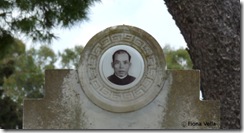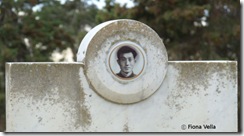Posts Tagged ‘Qingming Festival’
-
The Chinese who remained in Malta

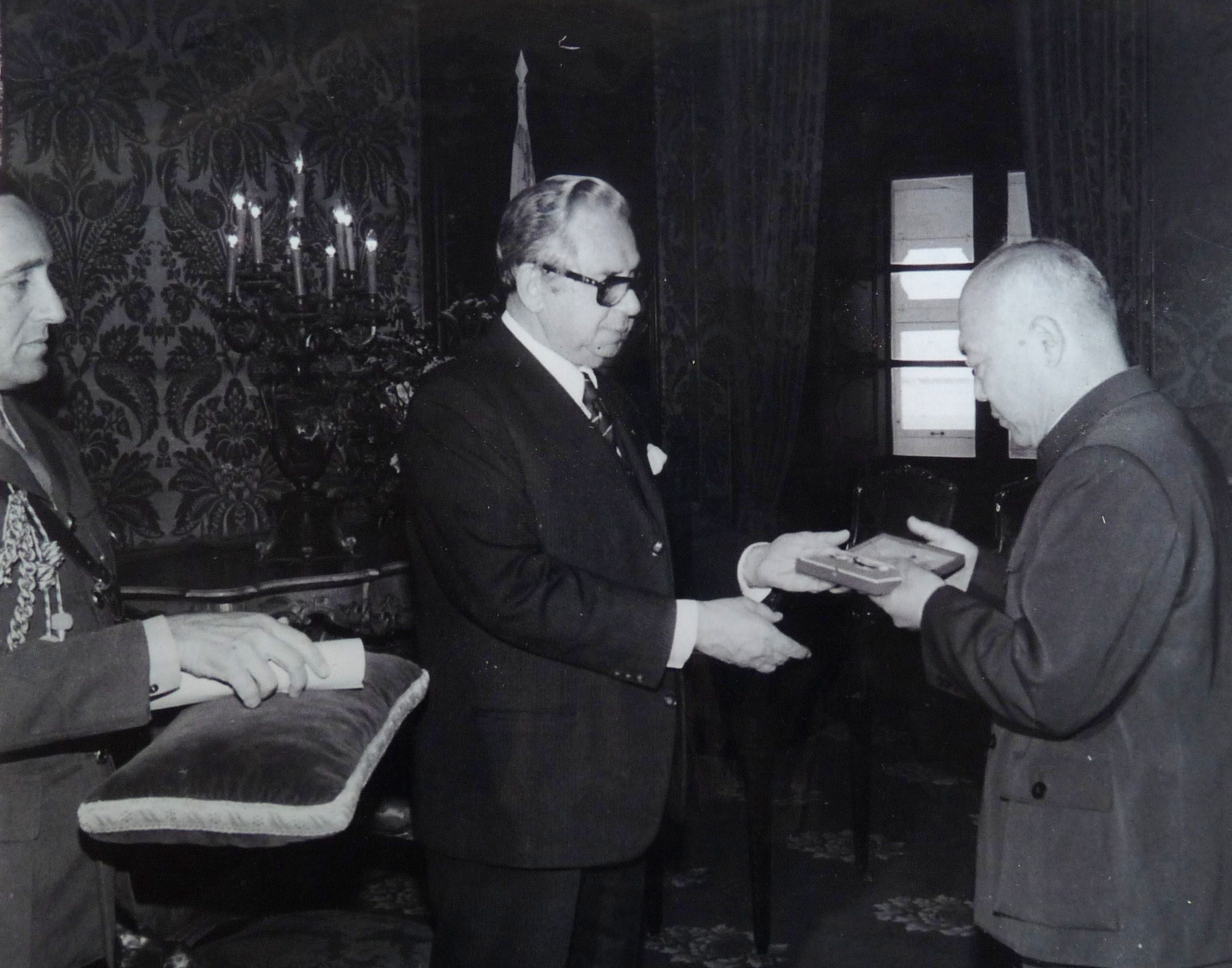

Last Sunday, many of us went to visit the cemeteries which are located around our islands in order to pay our respects to our dead relatives and friends.
Many of us took with them a beautiful bunch of coloured and fragrant flowers which we left on the cold tombs made of yellowish stone or of icy white or dark black marble. Apart from showing love and respect, this gesture seemed to try to inject life where there was not.
Others have also dedicated some time to clean the tombs by removing the weeds or by changing an old photograph with a new one.
Thousands of red candles were lit so that their humble flame might accompany the soft prayers that were said for the deads’ souls.
Many people had tears in their eyes. Even those whom their relatives had died a long time ago but still feel emotional at this loss.
I find these death rituals very interesting, particularly when I observe how society continues to keep dear to its heart those who have died; sometimes even by continuing to treat them as if they were still alive.
Whilst I walked along the paths of the Addolorata cemetery, I could notice all these customs. A pang of sadness crept into my heart when I noticed some bare tombs whom no one seemed to have visited. However, a closer look at the dates written on these tombs indicated that probably those particular families had ended and therefore nobody remained to visit.
The tombs of Xu Huizhong and Gu Yanzhao
I arrived in front of the tombs which I went to visit: those of Xu Huizhong and Gu Yanzhao; two Chinese engineers who died in our country whilst they were working on Dock Number 6 in Malta. Xu had died accidentally whilst Gu was deceased due to an illness.
Their photos looked at me and I greeted them in name of their country and in name of mine. As a sign of respect, I put a bunch of white and yellow chrysanthemums on their tombs according to Chinese tradition which symbolizes sadness and grief. Then, according to my culture, I prayed to God to give them eternal rest.
I remember that when I asked some Chinese individuals regarding why these two persons had been buried in Malta and were not taken back to their country, they informed me that this had been their relatives’ decision. This is because, according to Chinese culture, these individuals had to be buried in the country for which they were working because that was the only way how they could rest in peace: for they had to be present on the same land when the project on which they were working was successfully finished.
Notwithstanding this, I still wondered what these persons’ relatives might have felt when they had to allow those whom they had loved, to be buried in a foreign country, and so far away.
An honorary medal of the Republic of Malta for engineer Xu Huizhong
I continued to think about this and so I decided to talk to ex-Labour Minister, Reno Calleja, who in 1979 was sent by Malta Prime Minister, Duminku Mintoff in order to present an Honorary Award of the Republic of Malta to the family of engineer Xu Huizhong. This honour was given to this man after he died tragically on 16th March 1979 whilst he was working at the construction of a new dock in our country.
“That was a day which I will never forget!” revealed Calleja as soon as we started to discuss this matter. “More than that, I must say that personally, I consider that moment as the most salient one in my political career. I cherish it that much because on that day, I felt that I was becoming part of my country’s history; where Malta was presenting a very significant award to a foreign worker after his death, because he had lost his life whilst he was helping our country.”
An agreement between Malta and China
Calleja remembers clearly that period when China had agreed to help our country to regain its economic strength.
“In those years, even China was a relatively poor country but it chose to help Malta all the same. It is during such moments that one can see the true friendship of a country: when it helps you in times when it is not so strong itself,” insisted Calleja.
“The wise decision that Mintoff had made, when in 1972 he visited China with a Maltese delegation in order to meet Mao Zedong, after Nixon had did so too about a month before, was very much appreciated. And thanks to this choice, the Maltese people are still enjoying the benefit of this friendship, now that China has become a very rich country.”
Many Chinese workers help in the construction of Dock Number 6
“Apart from giving us financial support, the Chinese people helped us a lot by sending us many technical workers in order to attend to various important projects in Malta, including the construction of Dock Number 6,” Calleja continued to explain.
“These Chinese workers have worked along with the Maltese labourers and our people got enriched in the principles of work as they learnt about the Chinese culture from these people. It was a culture of a people of great humility with vast enterprise together with a devotional sense of duty towards their own country. The enthusiasm shown by the Chinese workers as they worked with quality and precision, even when they were doing this for another country, inspired the Maltese to behave like them. And if the Chinese labourers were working with much dedication in order to make their country proud, the Maltese labourers were getting busy so that their country would be thankful to them,” Calleja said.
“When Dock Number 6 was ready, I attended to the opening ceremony and I swear that I noticed many workers cry when they saw Mintoff’s face alight with satisfaction for the good job that everyone had made.”
Reno Calleja goes to China in order to present the Medal
Unfortunately, this fantastic narrative has also its negative side; including the instance of the death of engineer Xu.
“In 1979, I was invited to visit China in order to represent the Malta-China Friendship Society. When I advised the Prime Minister about this, he requested me to go to China in April because he had something in mind,” remembered Calleja.
“After a fortnight, Mintoff informed me that he had decided to give a Medal of the Republic of Malta on an honorary basis after his death to engineer Xu Huizhong and I was recommended to take it with me on my visit to China. Soon ex-President of Malta, Anton Buttigieg, organized a ceremony wherein he invited the ex-Ambassador of China in Malta, as a representative of the Government of the People’s Republic of China in order to present him with this medal. Then this medal was handed to me and I took it with me to China.”
Here, Calleja showed me some photographs of those distinguished moments.
“A very big ceremony was organized at the great Congress Hall in Shanghai in order to present this medal to engineer Xu’s family. For this event, I prepared a speech in Maltese which was translated in Chinese by a Maltese student. This student was Clifford Borg-Marks whom today is the Ambassador of Malta in China.”
“During this ceremony, I had the privilege to meet engineer Xu’s widow and his children who all appreciated very much this honourable award that our country had given them. However, I can never forget the sad face of his widow who thanked me respectfully and said nothing more.”
From then on, Calleja has kept in contact with Xu’s family.
“Regrettably, a year after I met her, Xu’s widow died of grief. Yet her children kept in contact with me and they came to Malta in order to visit their father’s grave. Now, Xu’s grand-daughter has informed me that when she grows up, she would like to become an engineer like her grandpa.”
Chinese traditions
An interesting fact is that the Chinese people do not celebrate the death rituals during our same period. Furthermore, they have more than one ceremony related to paying respect to their dead.
Qingming Festival
Among these traditions, there is the Qingming Festival or Tomb Sweeping Day. This festival takes place on the 4th or the 5th April, according to the traditional lunar calendar.
During this festival, the people remember and honour their ancestors by praying, cleaning tombs, re-painting calligraphy on tombs, burning incense or offering food, tea, drinks and other accessories on the tombs. Moreover, on this day, some people may carry willow branches with them or hang them on their doors in order to ward off the evil spirits which may roam around on Qingming.
Since the Qingming takes place with the beginning of the Spring season, these celebrations usually include also family outings and kite flying. Some farmers start ploughing their fields on this day.
The Ghost Festival
During this festival which takes place in August, people will pay respects to all deceased whether young or old. Some of the activities which take place during the Qingming are also undertaken throughout the Ghost Festival; including the offering of food and the burning of incense.
Other celebrations could include the releasing of miniature paper boats and lanterns on water. This ritual is intended to direct the lost ghosts and spirits to their resting places as some people believe that on this day, the deceased will visit the living.
(This article is a translation of the Maltese original version which was published in the series KOBOR IL-MALTI (Part 25) in Torċa dated 9th November 2014)
-
With a salutation

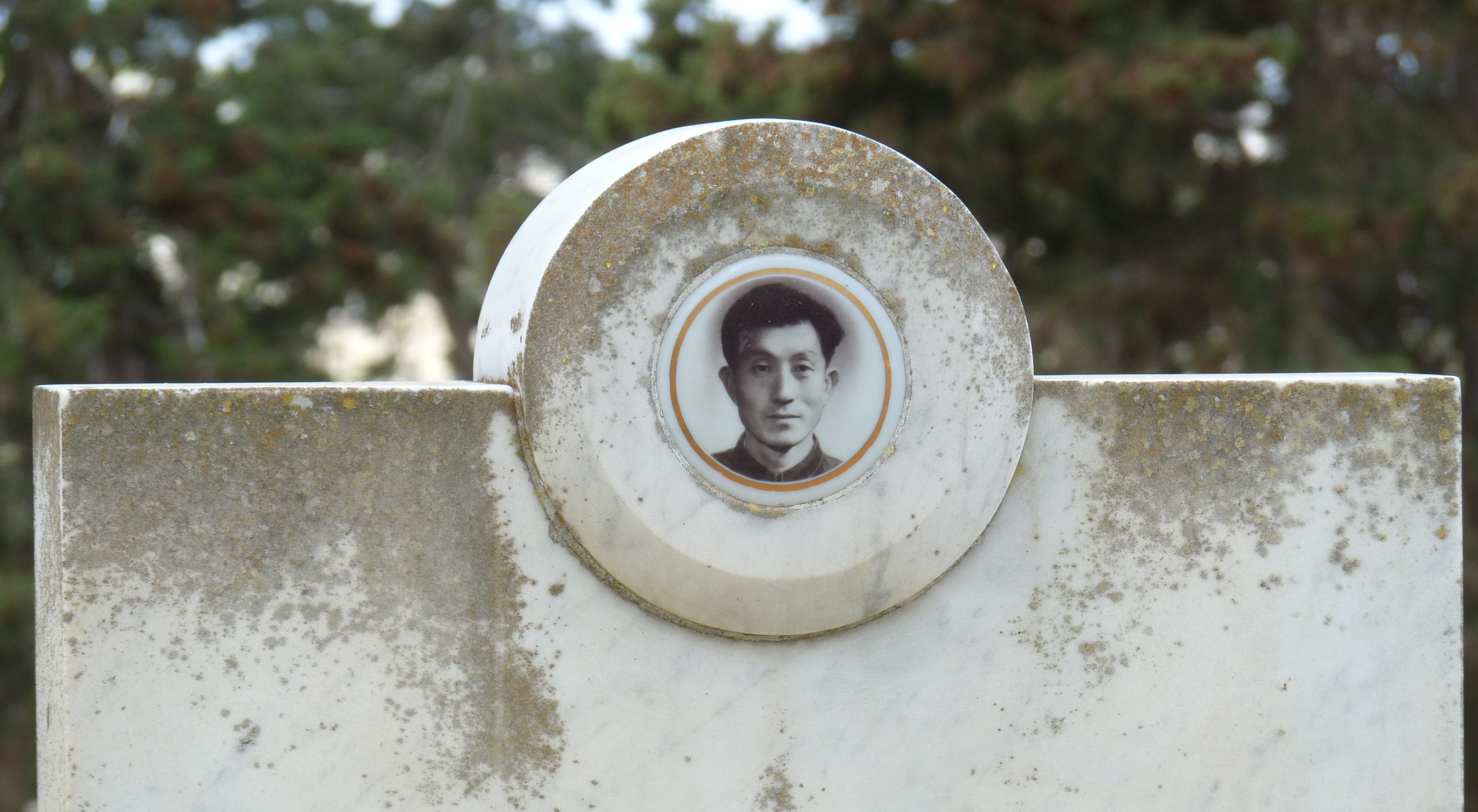
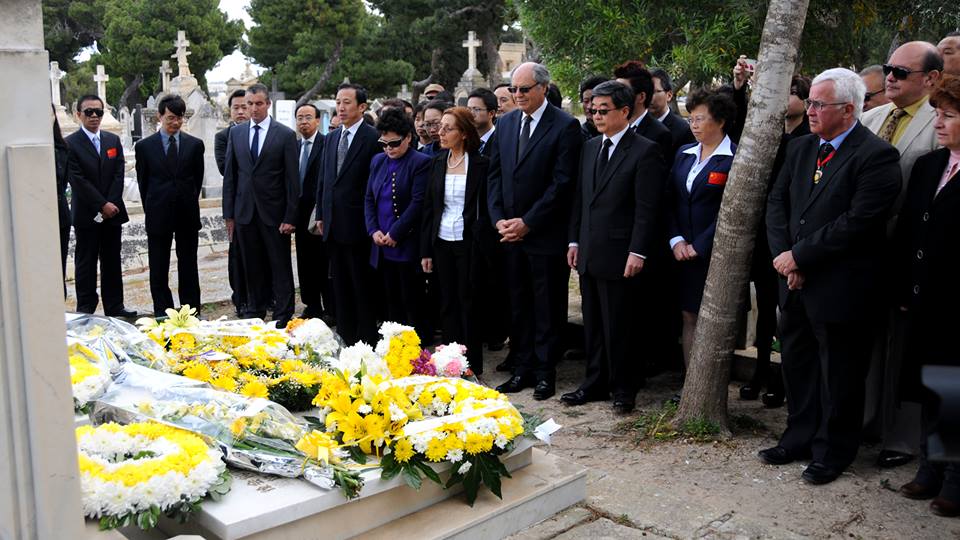
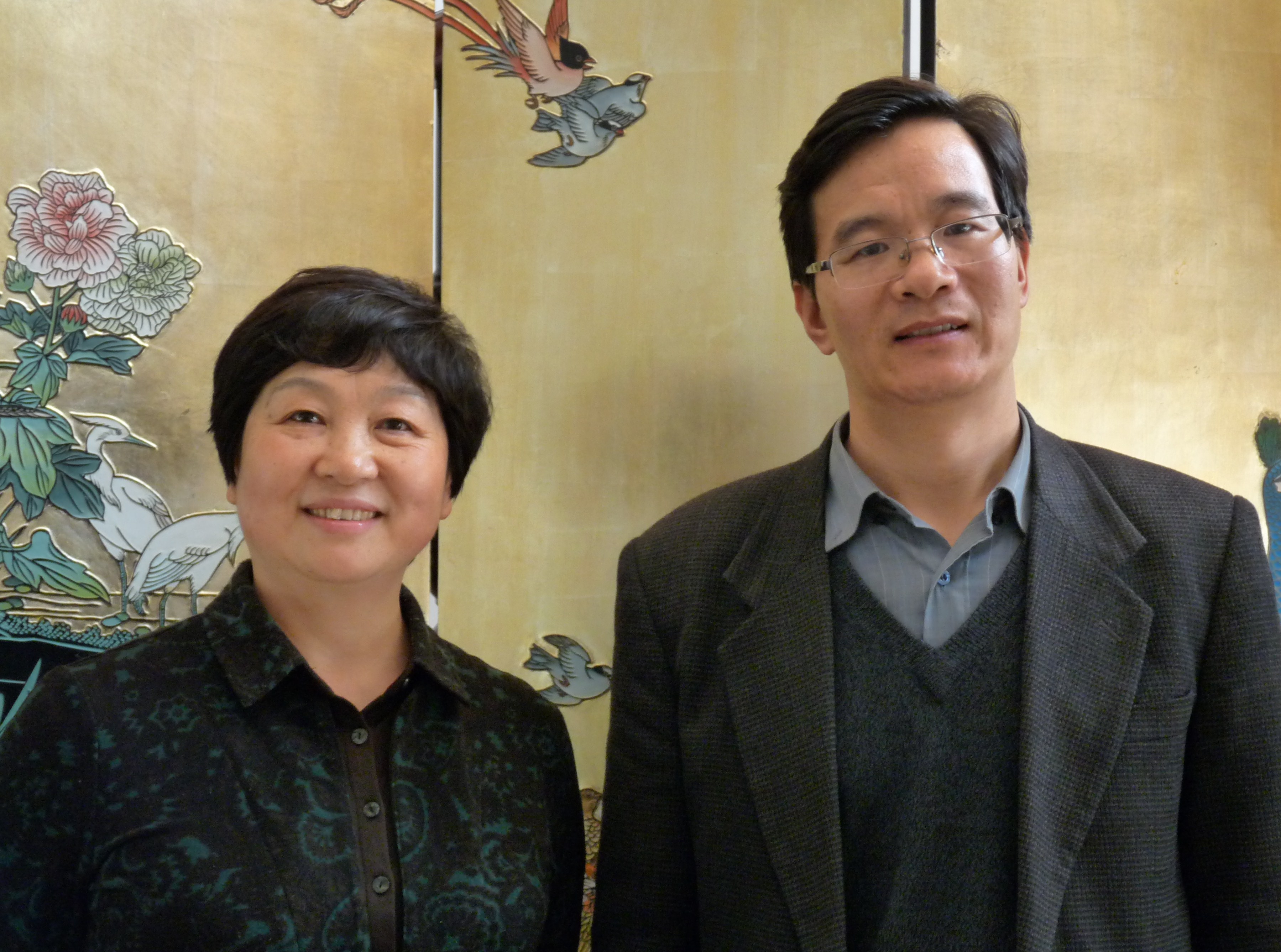
On 5th April 2014, representatives from the Embassy of the People’s Republic of China in Malta and a number of Chinese persons, together with some Maltese individuals, including Malta Minister of Finance, Edward Scicluna, Mayor of Santa Luċija, Frederick Cutajar, and members of the Malta-China Friendship Society, attended to a ceremony in respect of two Chinese workers who died in our country in 1979.
These two workers formed part of a group of hundreds of Chinese workers who were sent by the Chinese government in order to assist Malta in the construction of Dock Number 6 or as it is popularly known as the Red China Dock. This took place according to an agreement between China and Malta in the 1970s, wherein China agreed to help our islands in order to strengthen our economy.
The two Chinese workers who lost their life in Malta
Unfortunately, Xu Huizhong, a Chinese engineer aged 47, lost his life tragically on the 16th March 1979 whilst he was assisting in the construction of the dock. He was honoured with the Medal of Honour of the Republic of Malta on the 23rd April 1979. On the other hand, engineer Gu Yanzhao, died of natural causes at the age of 46.
These two Chinese workers were buried in Malta according to their relatives’ decision since in Chinese culture, it is believed that in order to rest in peace, these individuals had to be present on the same land when the project on which they were working was successfully finished. Moreover, they believed that in this way, they would continue to be remembered with respect by the Maltese people.
In the words of Minister Scicluna, “There is no higher sign of friendship than to give your life in order to help another country.” And now that with these articles, I am getting much fonder of China and its people, I could not allow myself not to investigate more this story and all the narrative that I knew that I would discover…
The ancient tradition of the Qingming Festival
I started my exploration by visiting the tomb of these two Chinese workers which is located at the Addolorata cemetery. I took with me a colourful bunch of flowers as a sign of respect and love. However, when I arrived in front of these tombs, I realized that I had met another Chinese cultural aspect as unlike my bunch, all the flowers that were left on these tombs after the ceremony, were white and yellow. As soon as I returned home, I researched about this and I learnt that this was part of the ancient Chinese tradition known as Qingming Festival.
In order to help me to understand better this concept, this week, I met Qiu Guangling and her assistant, Shi Qidong, at the Embassy of the People’s Republic of China in Malta. They informed me that this festival formed part of the 24 aspects of the Chinese lunar calendar wherein among the various celebrations, people celebrate the beginning of the Spring season and the rememberance of their dead ancestors. Some refer to this festival as Pure Brightness Day or Tomb-Sweeping Festival and this generally takes place around the 5th April.
The legend of Jie Zitui
Often, the Qingming Festival is associated with Jie Zitui who during the 7th century B.C. lived in the province of Shanxi. It is said that he was one of the few officials who followed Chong Er, the son of the Duke of Jin, when he had to leave due to severe restlessness in his country.
Chong Er lived for 19 years in exile and his situation became so miserable that eventually everyone abandoned him, except for five individuals, including Jie Zitui. This official respected his leader so much that when Chong Er was dying of hunger, he cut a piece from his thigh and cooked it for him so that he could get back his strength.
Finally, there came a time when Chong Er succeeded to win back his deserved throne and he returned to Jin as a leader. Together with him, he took those loyal officials who had remained with him through the worst time and he gave them the title of noblemen. Yet for some reason, Chong Er forgot Jie Zitui who now was an invalid due to the personal sacrifice that he had done for his master.
Nonetheless, when Chong Er realized his mistake, he immediately went to Mian mountain in order to find Jie Zitui who had gone to live there with his mother. But Jie Zitui had discovered serenity in this natural refuge of the mountain environment and he did not want to leave it to return to the city. Therefore, although he was aware that Chong Er was looking for him, he remained hidden with the hope that his friend will eventually give up and leave him alone.
Yet this did not take place, for Chong Er was so resilient to find him that he decided to set the mountain forest on fire in order to force his friend out of his hideout. The huge fire which was lit continued to burn for three days until all the mountain was burnt out. Alas, when the people of Chong Er went in to look for Jie Zitui, they found him burnt together with his mother.At these terrible news, Chong Er fell into miserable grief for what he had done and out of respect towards these two persons, he buried them at the foot of Mount Mian and changed its name to Jie. Moreover, he built a temple on it in honour of their memory.
In order to remember this tragedy, he ordered that each year in those particular three days, nobody could light a fire in his house and only cold food could be eaten. This started the Hanshi or the Cold Food Festival.
Then, around 300 years ago, during the Qing Dynasty, this festival was incorporated witin the Qingming Festival and this event was changed into a celebration of rememberance and sacrifice for the ancestors. Nowadays, the Cold Food Festival is celebrated a day before the Qingming and the activities continue for three whole days.
Just like we do in November, when we visit our cemeteries in order to show respect towards our dead relatives, in China these activities take place in April. Indeed, during this festival, a lot of Chinese people gather into cemeteries wherein they clean the tombs, repaint the calligraphy on them, burn incense and leave white and yellow chrysanthemums which in Chinese culture symbolize sadness and grief. Furthermore, they offer food and drink to their dead, and relatives meet on the tombs or in the surrounding gardens in order to eat together.
Yin House Feng Shui
It is interesting to know that when one is choosing a place for burial in China, usually, Feng Shui experts are called according to an ancient tradition. The main aim of Yin House Feng Shui is to choose the correct site for burial so that the energy of the dead is turned into a positive one in order to bring luck to their families. In fact, Chinese people believe that if the dead are not allowed to rest in peace in a place which guarantees their serenity, their living relatives would incur dire consequences.
The Imperial Tombs of China
This principle regarding tombs originated when man created the concept of a soul and therefore introduced also the idea of a life after death. Therefore, along the years we can observe various transitions in tombs which serve as a mirror of the ideas of the society which made them. In fact, as time passed, we can notice that tombs became more refined until in the period of the greatest dynasties, the imperial tombs took the shape of whole temples in the belief that the leader could continue to enjoy the same beautiful environment that he was used to during his life even after death.
The Mausoleum of Emperor Qin Shi Huang
This mausoleum was constructed by the Emperor Qin Shi Huang in the 3rd century B.C. in order to serve as his tomb. This enormous building was one of the first structures which were built for this reason, wherein the surrounding environment was chosen appositely in order to offer the right ambience to the emperor after his death.
According to ancient writers, originally, this mausoleum was around 120 metres high and its base was 2167 square metres. Many trees and plants were sown in the area in order to embellish the zone. A dike that was 10 metres high and 1400 metres wide was constructed to avoid inundation of the territory from the nearby rivers. Moreover, the course of the river that passed through the south of the mausoleum was altered and its new route led to Weihe river so that its waters would not be an obstacle.
It is estimated that around 12.8 million cube metres of earth were used in order to build the foundation of the emperor’s tomb and those of nearby tombs in the same site, together with the construction of the dike and the manufacturing of the statues that were made to adorn the place. Meanwhile, a further 1.2 million cubic metres of earth were required to fabricate the emperor’s tomb. It is interesting to note that all this stone was cut from the quarries of Mount Ganquan which was located 200 km away from the site of this mausoleum!
In the meantime, Emperor Qin Shi Huang ordered to put priceless artistic works of great skill in his tomb, including jewels made of gold and silver, artworks, writings, clothing and many more accessories. Finally, there was so much wealth in this mausoleum that it was too difficult to calculate how much time, work, material, money and lives it came to cost. Yet certainly, once the emperor died, he buried everything with him and without knowing, he conserved some of the best cultural treasures which were to be enjoyed by later generations.
However, the emperor wanted more than this as an accompaniment to his voyage after death. In fact, in order to build this tomb, apart from the best tradesmen who were selected, its construction which involved many years, was done my many criminals, by farmers who had not paid the taxes and by slaves. Besides the emperor’s tomb, these were ordered to build another tomb that was located around 1400 metres away and finally all the criminals were buried in it once the emperor was dead. In fact, during archaeological excavations, an area of 1200 metre squared of human bones was unearthed.
Ironically, though the emperor was preparing such a fantastic place for himself after death, he was terrified of death and he dedicated many years in search of the elixir of life in order to acquire the font of eternity. Since he was a cruel tyrant, there were several attempts on his life but he always succeeded to avoid getting killed. Until eventually luck left him when during one of his voyages, he swallowed some mercury pills which were supposed to prolong his life!
Ultimately, Emperor Qin Shi Huang was so much hated by the people, that his dynasty ended soon after his death and his tomb was robbed and burnt more than once. Yet this mausoleum was so huge that in 1974, whilst some Chinese farmers were digging to construct a well, they came upon another part of this site which was still intact and everyone was surprised.
A group of archaeologists was called in order to excavate this place and among the enormous and unique discoveries, they found also a whole army of terracotta soldiers which were accompanied by horses with carriages of actual size. Hundreds of such soldiers were found and each of them had individual faces with different characteristics. However, it is believed that there are around 8000 soldiers in all to be unearthed. Moreover, it seems that there are also 130 carriages with 520 horses, and 150 cavalry horses buried in this mausoleum.
Each year, this discovery attracts thousands of tourists to this site and when some of these artifacts are exhibited in other countries, many people go to visit them. This fact was confirmed also by the Senior Curator of the Malta National Museum of Archaeology, Sharon Sultana, when in 2007 an exhibition with 81 artifacts from the mausoleum of Qin Shi Huang, consisting of 10 terracotta soldiers and 2 horses were displayed in this museum.
Other traditions related to Qingming Festival
Since this festival takes place during the beginning of Spring, this is the time when farmers start to plough and sow their fields. This is also a period when many beautiful flowers enhance the Chinese landscape and so part of these celebrations include also walks in the splendid countryside. These days offer also particular moments for young people to meet and many new love stories begin at this time. As a cheerful greeting to this new season, the sky is filled with numerous kites that are made with great skill and in various forms and so these days are also enriched with beautiful and positive memories.
(This is a translation of an original article which was published in Maltese in the series PONT MAĊ-ĊINA (5th Part) in the newspaper Torċa dated 20th April 2014)
-
PONT MAĊ-ĊINA – IL-ĦAMES PARTI – B’tislima
Fil-5 t’April 2014, rappreżentanti mill-Ambaxxata taċ-Ċina f’Malta u numru oħra ta’ persuni Ċiniżi, ngħaqdu ma’ xi individwi Maltin, fosthom mal-Ministru tal-Finanzi, Edward Scicluna, mas-Sindku ta’ Santa Luċija, Frederick Cutajar u ma’ membri tal-Malta-China Friendship Society, sabiex jattendu għal ċerimonja ta’ tifkira taż-żewġ ħaddiema Ċiniżi li tilfu ħajjithom f’pajjiżna fl-1979. Dawn iż-żewġ ħaddiema kienu jiffurmaw parti minn mijiet ta’ Ċiniżi li ntbagħtu mill-gvern tagħhom f’pajjiżna, sabiex jgħinu fil-kostruzzjoni tad-Dry Dock numru 6, jew kif inhu magħruf illum, ir-Red China Dock. Dan sar wara ftehim fis-sebgħinijiet bejn iċ-Ċina u Malta, fejn iċ-Ċina qablet li tagħti daqqa t’id lill-gżejjer tagħna li kienu għadhom qed jirkupraw biex ikabbru l-ekonomija tagħhom.
Iż-żewġ ħaddiema Ċiniżi li tilfu ħajjithom f’Malta
Sfortunatament, Xu Huizhong, inġinier Ċiniż ta’ 47 sena, tilef ħajtu traġikament fis-16 ta’ Marzu 1979 waqt li kien qed jaqdi dmiru fil-bini tal-baċir. Huwa ġie onorat bil-Midalja Għall-Qadi tar-Repubblika fit-23 t’April 1979. Min-naħa l-oħra, l-inġinier Gu Yanzhao, miet b’kawża naturali fl-età ta’ 46 sena, waqt li hu wkoll kien qed jaħdem fl-istess baċir. Kienu l-familjari tagħhom stess li għażlu li dawn iż-żewġ ħaddiema jindifnu f’Malta sabiex b’hekk huma jsibu l-mistrieħ u l-paċi fil-pajjiż li ħadmu għalih. Il-familjari xtaqu wkoll li permezz ta’ din id-deċiżjoni, dawn l-għeżież tagħhom ikunu ‘preżenti’ meta l-proġett jitlesta u li l-quddiem, in-nies tal-lokal jibqgħu jiftakruhom b’rispett.
Fi kliem il-Ministru Scicluna, “M’hemmx sinjal akbar ta’ ħbiberija minn dik li tagħti ħajtek biex tgħin lil pajjiż ieħor.” U hekk kif bħalissa, permezz ta’ dawn l-artikli, qiegħda kull ma mmur nersaq u ninġibed aktar lejn iċ-Ċina u lejn niesha, ma stajtx inħalli dan il-mument jgħaddi mingħajr ma nistħarreġ aktar din l-istorja u dak kollu li bsart li se ġġib magħha….
It-tradizzjoni antika taċ-Qingming Festival
Bdejt billi żort il-qabar ta’ dawn iż-żewġ ħaddiema Ċiniżi li jinsab fiċ-ċimiterju tal-Addolorata. Miegħi ħadt bukkett fjuri sabiħ ikkulurit biex nuri sinjal ta’ rispett u mħabba. Iżda hekk kif wasalt quddiem il-qabar, mill-ewwel intbaħt li kont erġajt missejt ma’ xi aspett ieħor tal-kultura Ċiniża, hekk kif il-fjuri kollha li kienu tħallew qabel waqt iċ-ċerimonja msemmija, kienu ta’ lewn abjad u isfar. Mort mill-ewwel lura d-dar sabiex nifhem aħjar x’kien qed jiġri u sibt li din il-funzjoni annwali kienet tagħmel parti minn tradizzjoni antika Ċiniża magħrufa bħala Qingming Festival.
Sabiex jgħinuni nifhem aktar dan il-kunċett, din il-ġimgħa ltqajt ma’ Qiu Guangling u ma’ l-assistent tagħha, Shi Qidong, ġewwa l-Ambaxxata taċ-Ċina f’Malta. Huma infurmawni li dan il-festival jifforma parti mill-24 aspett tal-kalendarju lunari Ċiniż fejn fosthom matulu jiġu ċċelebrati l-bidu tar-Rebbiegħa, u t-tifkira tal-antenati u tal-mejtin. Hemm min jirreferi għal dan il-Festival bħala ‘Pure Brightness Day’ jew inkella ‘Tomb-Sweeping Festival’ u dan dejjem jaħbat madwar il-5 t’April.
Il-leġġenda ta’ Jie Zitui
Iċ-Qingming Festival sikwit jiġi assoċċjat ma’ Jie Zitui li fis-7 seklu Q.K. kien jgħix fil-provinċja ta’ Shanxi. Jingħad li hu kien wieħed mill-ftit uffiċċjali li segwa lill-Chong Er, it-tifel tad-Duka ta’ Jin, meta dan kellu jħalli l-pajjiż minħabba nkwiet kbir li nqala’. Chong Er għex għal 19 il-sena fl-eżilju u s-sitwazzjoni li kien jgħix fiha tant kienet miżerabbli, li finalment abbandunah kulħadd, apparti ħames individwi, fosthom Jie Zitui. Dan l-uffiċċjal tant kien jirrispetta lill-kap tiegħu li meta darba minnhom Chong Er kien qed imut bil-ġuħ, huwa qata’ parti minn kuxxtejh u sajjarhielu ħalli dan ikun jista’ jistejqer b’laħmu.
Intant, ġie żmien meta Chong Er irnexxielu jerġa’ jirbaħ it-tron li kien jistħoqqlu u huwa reġa’ lura lejn Jin bħala mexxej. Miegħu huwa ħa lill-uffiċċjali li kienu baqgħu leali lejh fi żmien tant imwiegħer u lil dawn tahom it-titlu ta’ nobbli. Imma għal xi raġuni, huwa nesa lil Jie Zitui li ormaj kien invalidu minħabba s-sagrifiċċju li kien għamel għall-kap tiegħu. Madanakollu, Chong Er ma damx ma ntebaħ bl-iżball li għamel u għalhekk huwa erħilha lejn il-muntanja Mian biex ifittex lil Jie Zitui, fejn dan kien mar joqgħod m’ommu. Iżda Jie Zitui kien sab l-hena fir-rifuġju tan-natura tal-ambjent tal-muntanja u b’xejn ma ried imur lura lejn il-belt. Għaldaqstant huwa baqa’ mistoħbi bit-tama li Chong Er jaqta’ qalbu u jħallih fil-paċi. Imma dan ma kellux ikun għax meta l-mexxej baqa’ ma sabx lil ħabibu, huwa tant webbes rasu li ried isibu, li ordna li l-foresta tal-muntanja tingħata n-nar ħalli Jie Zitui jiġi sfurzat joħroġ mill-moħba tiegħu. In-nar dam jaqbad tliet ijiem sakemm inħarqet il-muntanja kollha u meta n-nies ta’ Chong Er marru jfittxu lil Jie Zitui, huma sabuh maħruq flimkien m’ommu. Chong Er iddispjaċih ferm għalli ġara u b’rispett lejn dawn iż-żewġ individwi, huwa difinhom ħdejn il-muntanja Mian li bidlilha isimha għal Jie, u fuqha huwa bena tempju għall-memorja tagħhom.
Bħala tifkira ta’ din it-traġedja, huwa ordna wkoll li kull sena, proprju f’dawk it-tliet ijiem, ħadd ma seta’ jqabbad nar fid-dar, u l-ikel kellu jittiekel kiesaħ biss. Kien hawnhekk li ngħata l-bidu għal ‘Hanshi’ jew ‘Cold Food Festival’. Aktar tard, madwar 300 sena ilu, fi żmien id-Dinastija Qing, dan il-Festival twaħħad maċ-Qingming Festival u l-okkażjoni nbidlet f’waħda ta’ tikira u sagrifiċċju għall-antenati. Illum, il-‘Cold Food Festival’ jiġi ċċelebrat ġurnata qabel iċ-Qingming u l-attivitajiet jibqgħu sejrin għal tliet ijiem sħaħ.
Hekk kif aħna nagħmlu fil-bidu ta’ Novembru, meta nżuru ċ-ċimiterji u nuru r-rispett tagħna lejn qrabatna mejtin, fiċ-Ċina dan isir fil-bidu t’April. Għadd kbir ta’ nies jinġabru fiċ-ċimiterji biex inaddfu l-oqbra, jiżbgħu mill-ġdid il-kalligrafija li jkollhom miktuba fuqhom, jixgħelu l-inċens, u jħallu kriżantemi bojod u sofor, liema fjuri fil-kultura Ċiniża jesprimu s-swied il-qalb u n-niket. Barra minn hekk, huma joffru wkoll xi ikel u xorb lill-mejtin tagħhom u wara l-familjari jinġabru fuq il-qabar stess jew fil-ġonna tal-madwar sabiex jieklu dan l-ikel flimkien.
Yin House Feng Shui
Ta’ min isemmi illi meta jiġi biex jintagħżel sit għad-dfin, fiċ-Ċina jitqabbdu esperti tal-Feng Shui, liema użanza tikkonsisti minn forom ta’ arti u xjenza antiki li nħolqu f’dan il-pajjiż madwar 3000 sena ilu. L-għan prinċipali tal-Yin House Feng Shui huwa illi permezz ta’ għażla għaqlija tal-art fejn jindifnu l-mejtin, l-enerġija tagħhom tiġi mibdula f’enerġija pożittiva sabiex din tiġi riflessa f’riżq għall-familjari. Infatti ċ-Ċiniżi jemmnu illi jekk il-mejtin ma jitħallewx jistrieħu fil-paċi f’post li jassiguralhom serenità, il-familjari l-ħajjin isofru l-konsegwenzi.
L-oqbra imperjali taċ-Ċina
Dan il-prinċipju dwar l-oqbra ra l-bidu tiegħu meta l-bniedem ħoloq il-kunċett tar-ruħ u b’hekk daħħal ukoll l-idea ta’ ħajja oħra wara din. Għalhekk matul is-snin insegwu diversi tibdiliet fl-oqbra u dawn iservu bħala mera tal-ideat tas-soċjetà li tkun sawwrithom. Aktar ma jgħaddi ż-żmien, l-oqbra bdew kull ma jmur jirraffinaw ruħhom sakemm fil-perjodu ta’ wħud mill-aktar dinastiji qawwija, l-oqbra imperjali ħadu s-sura ta’ tempji sħaħ bil-ħsieb li l-mexxej seta’ jgawdi l-istess ambjent li kien imdorri fih f’ħajtu, anki wara mewtu.
Il-Musulew tal-imperatur Qin Shi Huang
Dan il-musulew inbena mill-imperatur Qin Shi Huang fit-3 seklu Q.K. sabiex iservi bħala l-qabar tiegħu. Din il-binja enormi kienet waħda minn ta’ l-ewwel ta’ din ix-xorta, fejn l-ambjent tal-madwar intagħżel apposta sabiex joffri l-atmosfera ġusta għall-imperatur wara li jmut. Skont kittieba antiki, oriġinarjament, dan il-musulew kien madwar 120 metru għoli u l-bażi tiegħu kellha qies ta’ 2167 metru. Diversi siġar u pjanti ġew imħawwla fl-inħawi sabiex isebbħu l-post, filwaqt li nbena lqugħ għall-ilma b’għoli ta’ 10 metri u tul ta’ 1400 metru ħalli jiġi evitat li l-ilma tax-xmajjar li kienu fil-qrib jgħerrqu l-inħawi. Barra minn hekk, inbidel il-kors tax-xmara li kienet tagħti lejn in-nofsinhar ta’ dan il-musulew u minflok il-passaġġ tagħha ddawwar fix-xmara Weihe ħalli b’hekk ilmijietha ma jkunux ta’ ostaklu.
Huwa stmat illi ntużaw madwar 12.8 miljun metru kubu ta’ art biex biha tissawwar l-art tal-qabar tal-imperatur u ta’ xi oqbra oħra fl-istess sit, flimkien mal-kostruzzjoni tal-ilqugħ tal-ilma u tal-istatwi li kellhom jitpoġġew fil-post. Barra minn hekk, kien hemm bżonn ukoll 1.2 miljun metru kubu ieħor ta’ art sabiex biha jinbena l-qabar tal-imperatur. Ta’ min isemmi illi dan il-ġebel kollu ġie maqtugħ minn barrieri fil-muntanja Ganquan li kienet tinsab 200 kilometru bogħod mis-sit tal-musulew!
Għal ġewwa dan il-qabar, l-imperatur Qin Shi Huang, ordna li jitpoġġew ukoll xogħolijiet imprezzabbli artistiċi u ta’ sengħa mill-aqwa, fosthom ġojjelli maħduma mid-deheb u l-fidda, tpinġijiet, kitbiet, ħwejjeġ u drappijiet u għadd ta’ dekorazzjonijiet oħra. Finalment, tant kien hemm ġid ġewwa dan il-musulew li huwa diffiċli biex wieħed jikkalkula kemm dawn setgħu swew ħin, xogħol, ħajjiet, materjal u flejjes. Imma ċertament, hekk kif l-imperatur miet u difen kollox miegħu, huwa refa wirt kulturali mill-ifjen għall-ġenerazzjonijiet ta’ wara.
Iżda l-imperatur ried aktar minn hekk bħala akkompanjament għall-vjaġġ tiegħu wara mewtu. Infatti biex inbena dan il-qabar, apparti li kienu ntagħżlu l-aqwa nies tas-sengħa, il-kostruzzjoni tiegħu li ħadet snin sħaħ, saret minn bosta kriminali, bdiewa li ma ħallsux it-taxxi, u skjavi. U flimkien mat-tiswir ta’ qabar l-imperatur, dawn kellhom jibnu wkoll qabar ieħor fuq art li kienet tinsab 1400 metru bogħod, li finalment laqgħet fiha lill-kriminali li ndifnu flimkien mal-imperatur mejjet. Infatti, waqt skavi arkeoloġiċi, instab li dan il-qabar kellu medda ta’ madwar 1,200 metru kwadru u li kien miżgħud bl-għadam uman.
Ironikament, għalkemm kien qed ilesti post tant fantastiku għal wara mewtu, dan l-imperatur kien beżgħan ferm mill-mewt u għamel snin sħaħ ifittex il-famuż eliżir tal-ħajja sabiex jakkwista l-font tal-eternità. Minħabba li hu kien tirann krudili, saru diversi attentati fuq ħajtu imma dejjem irnexxielu jiskappaha. Sakemm darba xortih ħallietu u huwa miet waqt vjaġġ wara li bela’ xi pilloli tal-merkurju li suppost kellhom itawwlulu ħajtu!
L-imperatur Qin Shi Huang tant kien mibgħud li wara mewtu, id-dinastija tiegħu ntemmet fi ftit taż-żmien u l-qabar tiegħu ġie misruq u maħruq aktar minn darba. Madanakollu, dan il-musulew tant kien massiċċ illi fis-sena 1974, waqt li xi bdiewa Ċiniżi kienu qed iħaffru bir, huma sfrundaw f’parti oħra li kienet għadha ma ġġarfitx u dak li nstab ħalla lil kulħadd mistagħġeb. Grupp ta’ arkeoloġisti ntbagħtu minnufih biex jiskavaw u jieħdu ħsieb is-sit fejn fost is-sejba enormi u unika, kien hemm armata kbira ta’ suldati tat-terrakotta akkumpanjati minn numru ta’ karrijiet biż-żwiemel, kollha b’daqs reali. Għalkemm instabu mijiet minn dawn is-suldati li kull wieħed ġie maħdum b’mod individwali u b’fattizzi u pożizzjonijiet differenti, huwa maħsub li b’kollox hemm madwar 8,000. Barra minn hekk, jidher li hemm ukoll 130 karru b’520 żiemel, u 150 żiemel tal-kavallerija midfuna f’dan il-musulew.
Kull sena din is-sejba tiġbed eluf ta’ turisti lejn dan il-post. U kull meta tittella’ xi esebizzjoni f’pajjiżi oħra b’xi wħud minn dawn l-oġġetti li nstabu, din dejjem ikollha ħafna konkorrenza. Dan stqarritu wkoll il-Kuratriċi Anzjana tal-Mużew Nazzjonali tal-Arkeoloġija f’Malta, Sharon Sultana, meta fl-2007 f’pajjiżna ttelgħet esebizzjoni b’81 artifatt minn dan il-musulew tal-imperatur Qin Shi Huang, li fosthom kienu jinkludu 10 suldati tat-terrakotta u żewġt iżwiemel.
Tradizzjonijiet oħra li jsiru waqt iċ-Qingming Festival
Peress li dan il-festival jaħbat ukoll mal-bidu tar-Rebbiegħa, dan hu ż-żmien meta l-bdiewa jibdew jaħartu u jiżirgħu l-art tagħhom. Hu wkoll perjodu fejn diversi fjuri sbieħ jibdew isebbħu l-inħawi u għaldaqstant, parti miċ-ċelebrazzjoni tinkludi wkoll mixjiet fil-kampanja. Dan huwa wkoll mument fejn bosta żgħażagħ jiltaqgħu flimkien u bosta stejjer ġodda ta’ mħabba jibdew proprju f’dawn il-ġranet. Bħala tislima ferriħija għall-bidu ta’ dan l-istaġun ġdid, is-sema tintela’ b’għadd kbir ta’ manuċċi (jew tajr) maħdumin b’sengħa mill-aqwa u f’forom diversi u b’hekk dawn il-ġranet jiżżewqu anki b’memorji sbieħ u pożittivi.
(Dan l-artiklu ġie ppubblikat fit-Torċa ta’ l-20 t’April 2014)
Travelogue
Archives
| M | T | W | T | F | S | S |
|---|---|---|---|---|---|---|
| « Jan | ||||||
| 1 | 2 | 3 | 4 | 5 | 6 | 7 |
| 8 | 9 | 10 | 11 | 12 | 13 | 14 |
| 15 | 16 | 17 | 18 | 19 | 20 | 21 |
| 22 | 23 | 24 | 25 | 26 | 27 | 28 |
| 29 | 30 | |||||
Recent Posts
- A MATTER OF FATE
- MALTA’S PREHISTORIC TREASURES
- THE MAGIC IS IN THE DETAIL
- THE SELLING GAME
- NEVER FORGOTTEN
- Ġrajjiet mhux mitmuma – 35 sena mit-Traġedja tal-Patrol Boat C23
- AN UNEXPECTED VISIT
- THE SISTERS OF THE CRIB
Comments
- Pauline Harkins on Novella – Li kieku stajt!
- admin on IL-KARNIVAL TRAĠIKU TAL-1823
- Albert on IL-KARNIVAL TRAĠIKU TAL-1823
- Martin Ratcliffe on Love in the time of war
- admin on 24 SENA ILU: IT-TRAĠEDJA TAL-PATROL BOAT C23
